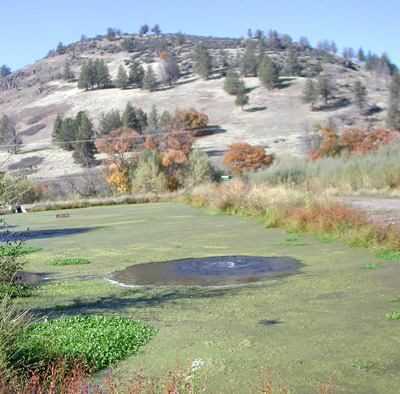Bibliography Background About KRIS
Total Maximum Daily Load (TMDL)
 The Clean Water Act , passed by Congress in 1972, protects drinking water and other beneficial uses, like recreation and fisheries resources. In northern California, beneficial uses include production of cold water fishes such as salmon, steelhead and coastal cutthroat trout. The U.S. Environmental Protection Agency (EPA) oversees programs to protect water quality under the Clean Water Act but delegates considerable responsibility to the California State Water Resources Control Board (SWRCB) and its regional boards.
The Clean Water Act , passed by Congress in 1972, protects drinking water and other beneficial uses, like recreation and fisheries resources. In northern California, beneficial uses include production of cold water fishes such as salmon, steelhead and coastal cutthroat trout. The U.S. Environmental Protection Agency (EPA) oversees programs to protect water quality under the Clean Water Act but delegates considerable responsibility to the California State Water Resources Control Board (SWRCB) and its regional boards.
In the 1970s and 1980s, the EPA and SWRQB focused on controlling pollution from point sources (e.g.. factory discharge, wastewater facilities, etc.) by improving treatment technology and developing water quality standards. Despite significant progress to improve water quality through point source controls, assessment reports have increasingly identified non point sources of pollution as major contributors to water degradation. Non point source pollution comes from diffuse sources across the landscape, such as agricultural runoff or erosion from roads and timber operations.
To address non point source pollution, EPA and SWRCB are promoting innovative watershed approaches involving multiple stake holders to augment traditional regulatory approaches. One mechanism to address both point and non point sources of pollution on a watershed basis is called Total Maximum Daily Load (TMDL). A TMDL is a quantitative assessment of pollution sources, and allocations to reduce pollution levels (U.S. EPA, 1991). TMDLs are required for water bodies listed as impaired or threatened, in accordance with Section 303(d) of the Clean Water Act (CRWQCB, 1998; 2002a). Elevated levels of sediment and temperature impact spawning and rearing habitat for fish and are considered the principle causes of impairment for north coast water bodies. Tributaries to San Francisco Bay are also listed as impaired due to the pesticide diazenon and have TMDL studies and plans for that pollutant (CRWQCB, 2002b).
In 1996, the Coast Action Group and the Sierra Club Legal Defense Fund launched a suit against the U.S. EPA and the SWRCB to force action on these impaired water bodies. The agencies settled out of court and agreed to a schedule for clean up and abatement of the identified water quality problems. The TMDL plan has been formulated for the Garcia River (U.S. EPA, 1998) and other basins (Kramer et al., 2001; Matthews Assoc., 1999; 2000a; 2000b, 2001a; 2001b) and a number more are scheduled to follow (TMDL Schedule). The Ninth Circuit Federal Court recently upheld the TMDL process in the Garcia River Basin (Prosolino vs. Nastri, 2002), and land owners will now develop management plans in order to come into compliance over the span of a decade.
The California Regional Water Quality Control Boards now also publish Basin Plans (CRWQCB, 2001), which set water quality objectives, an implementation plan and policies which form the basis for the control of water quality. These Plans reflect the desire of the SWRCB to regain a more proactive management stance as opposed to the reactionary one thrust on it by the TMDL process.
Northern California Total Maximum Daily Load Schedule
References
California Department of Fish and Game 2002. Water Quality Criteria for Diazinon and Chlorpyrifos. Attachment D in Chollas Creek Diazinon TMDL, Water Quality Criteria. Rancho Cordova, CA. [81pp]
California Regional Water Quality Control Board (CRWQB). 1998. Clean Water Act 303(d) TMDL timeline for California. CRWQCB, North Coast Region. Santa Rosa, CA. 10 pp. [36k]
California Regional Water Quality Control Board (CRWQCB). 2002a. 2002 Clean Water Act Section 303(d) list of water quality limited segments. CRWQCB, San Francisco Bay Region. San Francisco, CA. 199 pp. [711k]
California Regional Water Quality Control Board (CRWQCB). 2002b. Diazinon and pesticide related toxicity in San Francisco Bay urban creeks TMDL, September 2002. CRWQCB, San Francisco Bay Region. San Francisco, CA.
Kramer, S.H., M.Trso, and N.P. Hume. 2001. Timber harvest and sediment loads in nine Northern California watersheds based on recent total maximum daily load (TMDL) studies. Watershed Management Council Networker 10 (1): 1, 17-24. (1.97 Mb).
Matthews, Graham and Associates. 1999. Sediment Source Analysis and Preliminary Sediment Budget for the Noyo River. Prepared for: Tetra Tech,Inc. under contract 68-C7-0018, work assignment # 0-18. Matthews Assoc., Weaverville, CA.
Matthews, Graham and Associates. 2000a. Sediment source analysis and preliminary sediment budget for the Ten Mile River, Mendocino County, CA. Prepared for Tetra Tech, Inc. VOLUME 1: Text, Tables, and Figures. Fairfax, VA. 143 pp.
Matthews, Graham and Associates. 2000b. Sediment source analysis and preliminary sediment budget for the Ten Mile River, Mendocino County, CA. Prepared for Tetra Tech, Inc. VOLUME 2: Appendices. Fairfax, VA. 59 pp.
Matthews and Associates.2001a. Preliminary Sediment Budget Analysis for the Big River. Performed under contract for Tetra Tech and the U.S. EPA. Graham Matthews and Associates, Weaverville, CA.
Matthews (Graham) & Associates. 2001b. Sediment source analysis and preliminary sediment budget for the Albion River Watershed, Mendocino County, CA. (Contract 68-C99-249. Work Assignment #0-34.) Prepared for Tetra Tech, Inc. Fairfax, VA. 72 pp.
North Coast Regional Water Quality Control Board. 2001. Water Quality Control Plan for the North Coast Region. Staff report adopted by the North Coast Regional Water Quality Control Board on June 28, 2001. Santa Rosa, CA. 124 p. Appendix.
North Coast Regional Water Quality Control Board. 2002. Sonoma Creek sediment TMDL project plan. State Water Resources Control Board, North Coast Regional Board, Santa Rosa, CA. 2 pp. [162k]
Pronsolino v. Nastri F.3d. 7901 (9th Cir. 2002)
San Francisco Bay Region Water Quality Control Board. 2002. TMDL for Diazinon and Pesticide Related Toxicity in San Francisco Bay Area Urban Creek. Staff Summary Report, September 18, 2002.
U.S. Environmental Protection Agency (USEPA). 1991. Guidance for water quality-based decisions: The TMDL Process, EPA 440/4-91-001.Washington, DC- http://www.epa.gov/owow/tmdl/decisions.html
US Environmental Protection Agency (USEPA). 1998. (Final) Garcia River Sediment Total Maximum Daily Load. Dated 16 March 1998. USEPA, Region IX. San Francisco, CA. 51 pp. [130k]
US Environmental Protection Agency (USEPA). 1999. (Final) Noyo River Total Maximum Daily Load for Sediment. USEPA, Region IX. San Francisco, CA. 87 pp.
United States Department of Environmental Protection (EPA). 2000a. Navarro River total maximum daily loads for temperature and sediment. USEPA, Region IX. San Francisco, CA. 45 pp. [1.4Mb]
Web Sites for TMDL Information
State Water Resources Control Board Introduction to TMDL's
http://www.swrcb.ca.gov/rwqcb1/programs/tmdl/tmdlprogram.html
Wildland Hydrology - Documents about river morphology, stream classification, restoration and TMDL's, authored or co-authored by David Rosgen http://www.wildlandhydrology.com/html/references_.htm
